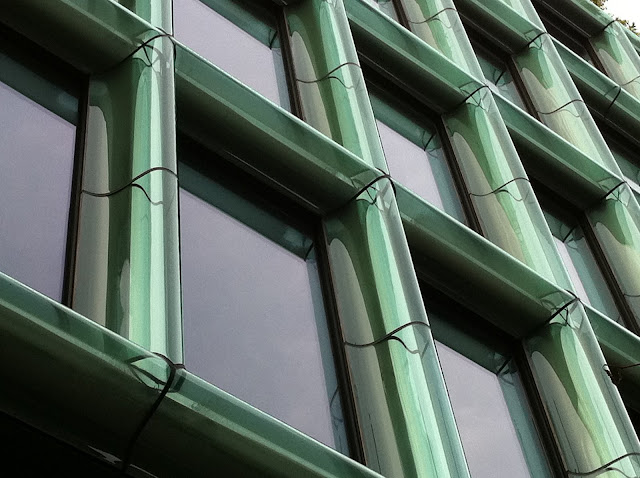The aim of this article is to explain the difference between two glass curving technologies: hot bending and cold bending.
Hot bending technology is based upon the following basic process [1]: a flat sheet of glass is placed upon a mould that has the desired bending radius and is heated evenly to temperature of 650ºC. At this temperature the glass changes to a visco-plastic state, loses its brittleness and stiffness, and can, therefore, be shaped by gravity or mechanical pressure, obtaining the aimed geometry by cooling.
Hot bending allows a broad variety of geometries and compositions -cylinders, s-curves, double curved shapes- to be achieved. The sheets are bent and then can be laminated and/or assembled into insulating glass units.
Manufacturers are steadily investigating, testing and, if the market demands it, expanding the manufacturing limits of radius, angle, thickness, girth and coatings, in order to offer architects and designers the largest sizes and greatest possibilities.
It is feasible in many cases to use coatings and ceramic frits in concave and convex sides, though the selection can be limited depending on varying factors such as glass thickness, size, radius, location adjacent to interlayers.
In order to attain a spherical, double curved and free form geometry with large deflections, curves with small radius such as 100 mm, processing with high temperatures is required.
Curved annealed laminated glass with a solar control and frit used on 40 Bond Street project, New York, 2006; Architect: Herzog & de Meuron (Produced by Cricursa, who have been bending glass since 1928)
Cold bending is a recent fabrication process. Flat glass panes are brought to the desired geometry by means of external contact pressure, which demands holding the curved glass unit in desired form.
Two basic techniques are used here: the glass can be curved at the construction site (and held in place by clamping strips) or curved in factory before laminating (and held in place by the interlayer).
The company seele sedak has been instrumental in the development of a new lamination bending technology [2], which consists on using shear stiff laminates, to produce extreme large bent glass panels.
The Lamination process of cold bent glass can be divided into four basic steps [2]:
1.- Put together interlayers and flat glass, usually tempered. The glass can also be heat strengthened, annealed, with ceramic frits or coatings though these may affect the limits of what is possible.
2.- The glass is formed into the desired shape by physically pressing it onto the laminating framework and clamped into place.
3.- Lamination process, the aim is to achieve a high shear bond between the glass and the interlayer.
4.- Release from the scaffold form. During and after the lamination process, high quality control and observance of the stresses in the single panes due to the spring back effect is necessary. It is required to increase the curvature in the panel during the lamination process to get the exact shape after releasing the laminated panel from the framework.
Both technologies provide fully bespoke, custom design solutions and the research and testing ensures the success of the most innovative designs.
Bridge made of cold-shaped glass and spanning seven metres (by seele sedak, Glasstec 2008)
[1] Cricursa General catalogue
[2] Bruno Kassnel-Henneberg, seele sedak. Purely structural glass building envelopes (Glass Performance Days 2011)
With editing by charles.bostick@seele.com
Source: renatocilento.blogspot.com
Repost from the GKD pressroom

